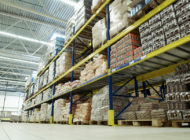As your food and pharmaceutical products flow through the supply chain, logistics providers must meet the environmental (i.e., climate and temperature) requirements of these items every step of the way. The quality and purity of these products – along with public health – depend on it. So, as your products will spend a lot of their supply-chain time in a warehouse, it is vital that you partner with a warehousing 3PL provider that can maintain optimal environmental conditions. In this article, we’ll look at some of the terms you’ll need to understand when speaking to a 3PL about warehouse temperature and climate.
12 key warehouse temperature terms you need to understand
![]() Let’s start with the basics. When we talk about temperature, we are typically talking about specific temperature ranges. Most food and pharmaceutical products have a temperature range that they must stay within at all times. The most common ranges are:
Let’s start with the basics. When we talk about temperature, we are typically talking about specific temperature ranges. Most food and pharmaceutical products have a temperature range that they must stay within at all times. The most common ranges are:
- Ambient. Refers to the natural temperature of the warehouse
- Air conditioned. Typically refers to a temperature between 56°F and 75°F. Confectionery products are a good example of a product that must avoid hot and cold extremes
- Refrigerated. Typically refers to a temperature between 33°F and 55°F
- Cold/Frozen. Typically refers to a temperature at or below 32°F
Now that we have ranges covered, the following are additional temperature and climate-related food warehousing terms you’ll need to understand.
- Temperature-controlled storage. A warehouse that has temperature-controlled space utilizes cooling (and/or heating) units to keep the temperature within a set range. These units are strategically placed throughout the space to ensure that the area stays in range. A variety of factors will affect the quantity and placement of cooling units, including the season of the year (i.e., more units may be needed during the summer), ceiling height, density of insulation, and warehouse building materials.
- Climate-controlled storage. While many people use this term interchangeably with temperature-controlled storage, there are key differences between the two. With climate-controlled storage, the humidity of the space is regulated in addition to temperature. Commercial humidifiers/de-humidifiers are used along with other equipment to ensure that humidity stays within required ranges for products.
- Temperature mapping. This process utilizes sensors to measure temperature in different areas of the warehouse space. Most 3PLs will go through a temperature mapping process several times a year and adjust cooling or heating equipment based on the results. For example, if mapping shows that an area is too warm, the placement of cooling equipment will be adjusted.
- Temperature monitoring. While temperature mapping is a proactive method of ensuring optimal temperature coverage, temperature monitoring is the day-to-day observation and management of those temperatures. 3PLs like Kanban partner with external monitoring companies to track temperatures in real time and alert key personnel of any significant changes immediately. These personnel are also able to monitor real-time temperatures themselves via applications provided by the monitoring company.
- Racking. Palletized products stored in a 3PL warehouse can be placed directly on to the warehouse floor or stored within racking systems. Such racking allows for products to be stacked upon each other in order to conserve floor space and take up a smaller warehouse footprint. Racking is beneficial within temp-controlled space as such space is typically more expensive, and a smaller footprint results in a lower cost to the customer.
- Lot control. Items that have common characteristics important to the manufacturer (e.g., the same expiration date) are given a lot number by the manufacturer and/or by a 3PL’s warehouse management system as they are received by the warehouse. This lot number allows 3PLs to quickly identify batches of items in the event of a recall. It also enables the 3PL to perform inventory management protocols like FIFO (first in first out; the oldest lots of items will be distributed first) and FEFO (first expired first out; the products closest to their expiration dates will be distributed first).
- Mock recalls. These are not real recalls but are instead “practice runs” should a real event ever be necessary. But don’t let the “practice” term fool you – 3PLs handle mock recalls just like the real thing, with full coordination among the customer, its WMS, and its own associates.
- Current Good Manufacturing Practice (CGMP). These are the Food and Drug Administration’s (FDA) regulatory standards for pharmaceuticals to ensure their quality, strength and purity. They apply to drugs and their manufacturing processes as well as the warehouses that store them. CGMPs related to pharmaceutical warehousing include items related to contamination prevention, lot control, distribution processes and storage requirements.
- Food Safety Plan. Under the Food Safety Modernization Act (FSMA), producers of food products must create a Food Safety Plan that seeks to minimize the risk of food contamination. According to the FDA, the Plan must include a hazard analysis, preventive controls to address potential problems, and a plan for oversight and management of preventive controls. You will need to inform your 3PL of your products’ specific requirements and ensure that they can be met.
Turn to Kanban for warehouse temperature and climate security
Located in Eastern North Carolina, Kanban Logistics is one of the few providers in the region that can perform temperature- and climate-controlled warehousing for food and pharmaceutical companies. We have consistent superior ratings from AIB International, while our ISO-9001:2015-certified operations adhere to all CGMP and FSMA regulations. Contact Kanban today to learn more about our capabilities and the ways we can protect the integrity of your products.


